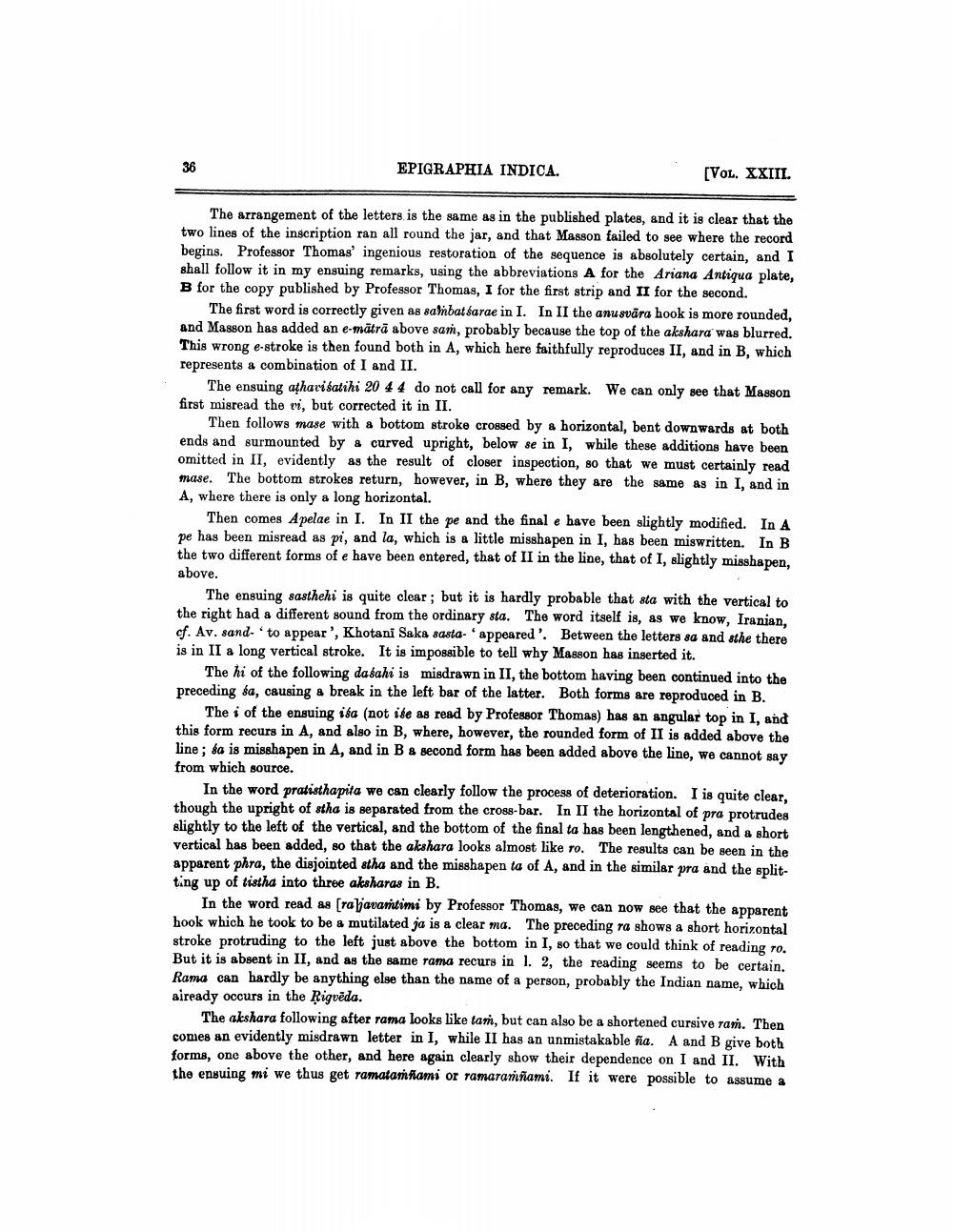________________
EPIGRAPHIA INDICA.
(VOL. XXIII.
The arrangement of the letters is the same as in the published plates, and it is clear that the two lines of the inscription ran all round the jar, and that Masson failed to see where the record begins. Professor Thomas' ingenious restoration of the sequence is absolutely certain, and I shall follow it in my ensuing remarks, using the abbreviations A for the Ariana Antiqua plate, B for the copy published by Professor Thomas, I for the first strip and II for the second.
The first word is correctly given as sambat sarae in I. In II the anu svāra hook is more rounded, and Masson has added an e-mätrā above saṁ, probably because the top of the akshara was blurred. This wrong e-stroke is then found both in A, which here faithfully reproduces II, and in B, which represents a combination of I and II.
The ensuing athavitatihi 20 4 4 do not call for any remark. We can only see that Masson first misread the vi, but corrected it in II.
Then follows mase with a bottom stroke crossed by a horizontal, bent downwards at both ends and surmounted by a curved upright, below se in I, while these additions have been omitted in II, evidently as the result of closer inspection, so that we must certainly read mase. The bottom strokes return, however, in B, where they are the same as in I, and in A, where there is only a long horizontal.
Then comes Apelae in I. In II the pe and the final e have been slightly modified. In A pe has been misread as pi, and la, which is a little misshapen in I, has been miswritten. In B the two different forms of e have been entered, that of II in the line, that of I, slightly misshapen, above.
The ensuing sasthehi is quite clear; but it is hardly probable that sta with the vertical to the right had a different sound from the ordinary sta. The word itself is, as we know, Iranian, ef. Av. sand- 'to appear', Khotani Saka sasta- ' appeared'. Between the letters sa and sthe there is in II a long vertical stroke. It is impossible to tell why Masson has inserted it.
The hi of the following daśahi is misdrawn in II, the bottom having been continued into the preceding ea, causing a break in the left bar of the latter. Both forms are reproduced in B.
The i of the enguing isa (not ide as read by Professor Thomas) has an angular top in I, and this form recurs in A, and also in B, where, however, the rounded form of II is added above the line; da is misshapen in A, and in B & second form has been added above the line, we cannot say from which source.
In the word pratisthapita we can clearly follow the process of deterioration. I is quite clear, though the upright of stha is separated from the cross-bar. In II the horizontal of pra protrudes slightly to the left of the vertical, and the bottom of the final ta has been lengthened, and a short vertical has been added, so that the akshara looks almost like to. The results can be seen in the apparent phra, the disjointed atha and the misshapen ta of A, and in the similar pra and the splitting up of tistha into three aksharas in B.
In the word read as [rahavartimi by Professor Thomas, we can now see that the apparent hook which he took to be a mutilated ja is a clear ma. The preceding ra shows a short horizontal stroke protruding to the left just above the bottom in I, so that we could think of reading ro. But it is absent in II, and as the same rama recurs in l. 2, the reading seems to be certain. Rama can hardly be anything else than the name of a person, probably the Indian name, which aiready occurs in the Rigvēda.
The akshara following after rama looks like tam, but can also be a shortened cursive ram. Then conies an evidently misdrawn letter in I, while II has an unmistakable fia. A and B give both forms, one above the other, and here again clearly show their dependence on I and II. With the ensuing mi we thus get ramatamfiami or ramaranhami. If it were possible to assume a




